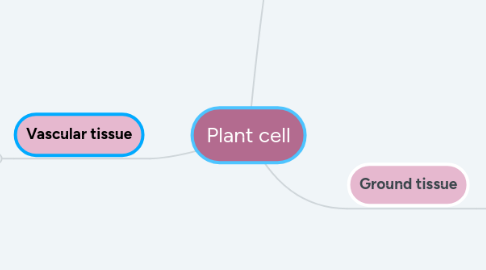
1. Epidermal tissue
1.1. Structure
1.1.1. closely packed cell
1.1.1.1. secrete waxy cuticle
1.2. Function
1.2.1. provide a protective barrier against mechanical injury,water loss and infection
2. Ground tissue
2.1. Parenchyma
2.1.1. Structure
2.1.1.1. cells are loosely arranged with many intercellular air spaces
2.1.2. Location/Distribution
2.1.2.1. In cortex, pith, packing tissues in phloem and xylem
2.1.3. Function
2.1.3.1. packing tissues in stems and roots for support and turgidity
2.1.3.2. potentially meristematic (root and shoot tip)
2.1.3.3. allow gaseous exchange
2.1.3.4. storage organ for food (potato)
2.1.3.5. site of photosynthesis
2.1.3.6. secretion (eg: resin)
2.2. Collenchyma
2.2.1. Structure
2.2.1.1. Cells are closely packed cells with a little or few intercellular air spaces
2.2.2. Location/distribution
2.2.2.1. Below epidermis in stems and petioles of leave. This allows them to bend in the wind
2.2.3. Function
2.2.3.1. Give mechanical strength and flexibility/elastic support. (allow cell to expand as it growth-stretchable)
2.2.3.2. As supporting tissue in herbaceous plant/young parts of plant/soft and non-woody plant organ
2.3. Sclerenchyma
2.3.1. Structure
2.3.1.1. Cells are closely/tightly arranged with no intercellular space
2.3.2. Location/distribution
2.3.2.1. Fibers- vessel elements and tracheid of xylem
2.3.2.2. Sclereids- give hard structure and gritty structure in pears and guava
2.3.3. Function
2.3.3.1. Give mechanical strength, structural support and rigidity to the plant result of lignin deposition in secondary walls
2.3.3.2. Give protection from mechanical damage
3. Vascular tissue
3.1. Xylem
3.1.1. Tracheids
3.1.1.1. Structure
3.1.1.1.1. cylindrical shape with tapering ends which is overlaps and interlocked with one another
3.1.2. Vessel element
3.1.2.1. Structure
3.1.2.1.1. Cylindrical shape with less tapering ends (end wall forming partially or completely perforated end wall)
3.1.3. Function
3.1.3.1. Transport water and minerals through vessel elements and tracheid
3.2. Phloem
3.2.1. Sieve tube
3.2.1.1. Structure
3.2.1.1.1. Large in diameter, long tube with no nucleus. Assist by companion cells for functioning because at maturity, most of the organelles are degenerate
3.2.1.1.2. Have perforated ends forming sieve plate
3.2.1.2. Function
3.2.1.2.1. Transporting sucrose and organic substances from leaves throughout plant
3.2.2. Companion cells
3.2.2.1. Structure
3.2.2.1.1. Shorter and smaller with dense cytoplasm
3.2.2.1.2. no perforated ends
3.2.2.2. Function
3.2.2.2.1. Assist sieve tube
